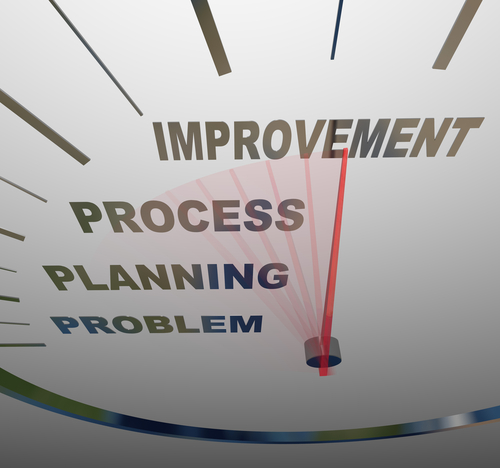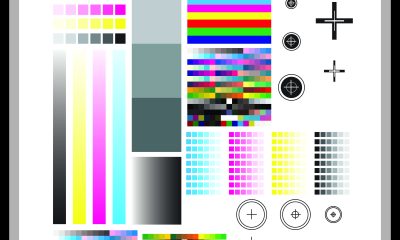News & Trends
Digital vs. Screen and the Dilemma of Process Improvement
Published
12 years agoon

In the February/March issue of Screen Printing, I talked about what’s really driving the relentless contraction of run length. For those that missed it, the quick difference is that the old graphic-communication model was based on mass production of printed units. To get the cost per unit low enough to justify a campaign, the run length was increased to lower the proportional cost of the prepress and set-up.
In the February/March issue of Screen Printing, I talked about what’s really driving the relentless contraction of run length. For those that missed it, the quick difference is that the old graphic-communication model was based on mass production of printed units. To get the cost per unit low enough to justify a campaign, the run length was increased to lower the proportional cost of the prepress and set-up.
To remain economically viable, screen has been focusing on reduced setup times and heightened production efficiencies. This has been the way we’ve always handled it—we simply look for ways to reduce non-billable or non-value-add time within the overall transaction. We aren’t alone here. Every other analog printing method has looked to this model as well.
Back in the early 1990s, Total Quality Management (TQM) sought to create flexible manufacturing cells capable of producing very small lots. This was extended in Lean Manufacturing as a method to eliminate all waste. This includes any time that‘s not directly buidable into the value of the final product.
Like TQM, Lean aims to create an economic value unit of one. This is consistent with the convergence we see with the digital model. So far, so good. We’re all on the same page when it comes to getting rid of waste. So why won’t this work moving forward for screen printing?
The real issue is the total cost of operation. There are two components here, the first being the material cost of set-up. This includes all the prepress costs: image prep, ripping, film (if not direct), screens, and screen prep labor. It also includes the labor to set up the press and the associated run-up costs of getting the press sheet dialed in for color and fit.
AdvertisementWe can’t do much about the prepress costs other than skipping the film portion and going direct to screen. The screen and mesh amortization, emulsion, and imaging costs are limited. We might be able to save some exposure time by using pure photopolymers, but this is a relatively low savings.
On the set-up side of things, the more control we have over ink flow and press set-up, the faster we’ll come up to color and fit. The work to achieve this was done way back in the mid 1980s with high tension mesh and thixotropic UV inks. Ink shear became a very predictable model. Sadly, many companies are still fighting this battle when it should have been history two decades ago.
Optimization
What has kept the screen-printing industry from succeeding at optimization has to do with resistance to change. The old model is based on years of experience being rewarded in a high hourly wage rate. This high labor cost caps how much we can save through increased efficiency.
Color management was introduced as a method of control to combat this problem. The result is that ICC color management has commoditized output quality. If you’re using a digital printer, and have properly profiled the press, ink, and substrate, the results will be the same if the operator is paid $25.00/hr or $2.00/hr. This means whoever has the lowest labor cost is going to get the work, unless you can change the equation. This will be a very important part of what I will address shortly.
When a market is growing there’s little motivation to curb costs or to optimize. When the market plateaus and begins to decline, the focus is on cutting costs and improving efficiency. This is an effort of diminishing returns. For screen printing the problem is that the expensive, experienced technicians (pressmen) have an analog paradigm. It has always been hard to get them to embrace controls and standardization at the core of ICC, G7, or any other standards-based system.
The reason is simple, once a system is controlled, the value of having skilled technicians diminishes. Look at what has happened to litho. It has so focused on setup and cost reduction that it’s now able to compete with screen, especially in large format. The run sizes have dropped to less than 1000 sheets on presses fully capable of running 18,000 impressions/hr all day long. Electronic prepress, direct-to-plate, and full color management have driven the cost and economic run length (ERL) down, down, down. But this industry segment is still collapsing. Why? Because they need to be competitive at a unit of one.
AdvertisementMeasuring as compared to digital
Digital has fundamentally changed the underlying economics of what we do and the way graphics are purchased. It is doing this in the same way it ravaged the television, music, video/motion picture, and publishing industries. While this is a grim reality, it does not mean we have to fully accept it as our inevitable future.
Understand the entire graphic communication industry was based on mass produced advertising volume. It is push based, where the industry pushes advertising out to the market and bases its value on cost per thousand (CPM) views or units produced. It cannot be measured effectively. The only metrics are aggregate metrics for the entire campaign.
Digital is different. It is based on a personalized unit of one. Everything about digital can be measured. As a result, the underlying production model we have used for the last 150 or more years is no longer relevant. It doesn’t matter how efficient you are if you can’t deliver graphics that fit into a metric-driven, analytic, ROI model.
This is a huge difference. Push based marketing is considered an expense, hence the focus is on reducing costs. This is something you cannot win. Digital is a pull-driven market where every individual instance is measured for an increase in ROI. Hence, it is an investment-driven model.
This is where screen printing loses the game. When advertisers can measure results down to the individual location, they don’t care what the cost is, as long as the return on their advertising investment meets or exceeds their expectation. They’re able to customize the graphics to each individual store, location, demographic, ethnicity, inventory item, and preference. It is as close to 1:1 marketing as we can get with this model.
This means the inevitable is variable-data printing (VDP), where the graphic content is determined based on rules merged from disparate and unconnected databases. The direct-mail industry has been doing this for years. It’s not a new concept. The granularity, or the resolution, of the offering is what’s new. New opportunities present themselves as computation speed increases and data move increasingly to the cloud. Whether we can take advantage of them or not will depend on how open our industry is to new ideas.
AdvertisementAs I see it, the problem is one of vision and willingness. I don’t hear many people talking about this. It’s as if owners and management are in denial with their heads stuck in the sand. It’s been easy to blame poor performance in the last few years on a crappy economy. But that isn’t totally to blame. Times are changing and with them, so is our need to adjust.
We have some transition options available for now, but they are becoming increasingly limited. Run length will continue to decrease until only what is needed to drive the sale is produced. We can’t stop that. It’s an inevitable outcome. Our future lies in understanding what’s really going on and developing meaningful and effective solutions that add value for our customers.
The future of screen will be about integration. It relies on how we integrate into a digital economy and how we integrate with other digital processes. It’s foolish and naïve to think we will remain a viable option because we have better outdoor durability, size, or substrate variety. These were all historical values that have been eclipsed by digital. We still have a small speed advantage on longer runs, but as we have seen, that is increasingly irrelevant as well.
So what are the options? What can we do to add value? Clearly, there are no simple answers. We are a mature industry with established relationships. Our customers have come to know us and trust us. Sure, they are focused on cost, but that is what has driven everyone in the past. The vision and willingness I spoke of earlier have to do with stepping up and providing leadership.
Our customers look to us for leadership. When you take a total customer perspective, you have a responsibility to present solutions that maximize your customer’s potential through the use of what you sell them. That is the living definition of value.
Willingness means moving off the current model you are using within your company. This is scary and a big risk. Nobody wants to make a costly mistake. No one wants to move away from what they know into the unknown. But think about this for a minute.
Your new competitors don’t have that irrelevant, historically based model holding them back. They don’t have the internal friction of a mature workforce resisting change. They also don’t have the customer base and the relationships you have.
That being said, if you fail to step-up and provide the vision and leadership to your established relationships, you’ve just opened the door. You’ve opened the door to a new, aggressive competitor who’s more agile, lower cost, and is now competing with you head-to-head. You’ve just handed over the one advantage you had.

SPONSORED VIDEO
Let’s Talk About It
Creating a More Diverse and Inclusive Screen Printing Industry
LET’S TALK About It: Part 3 discusses how four screen printers have employed people with disabilities, why you should consider doing the same, the resources that are available, and more. Watch the live webinar, held August 16, moderated by Adrienne Palmer, editor-in-chief, Screen Printing magazine, with panelists Ali Banholzer, Amber Massey, Ryan Moor, and Jed Seifert. The multi-part series is hosted exclusively by ROQ.US and U.N.I.T.E Together. Let’s Talk About It: Part 1 focused on Black, female screen printers and can be watched here; Part 2 focused on the LGBTQ+ community and can be watched here.
You may like
Advertisement

The Profit Impact of a Market Dominating Position

Inkcups Announces New CEO and Leadership Restructure

Hope Harbor to Receive Donation from BlueCotton’s 2024 Mary Ruth King Award Recipient
Advertisement
Subscribe

Bulletins
Get the most important news and business ideas from Screen Printing magazine's news bulletin.
Advertisement
Most Popular
-

 Case Studies2 months ago
Case Studies2 months agoHigh-Density Inks Help Specialty Printing Take Center Stage
-

 Art, Ad, or Alchemy2 months ago
Art, Ad, or Alchemy2 months agoF&I Printing Is Everywhere!
-

 Andy MacDougall2 months ago
Andy MacDougall2 months agoFunctional and Industrial Printing is EVERYWHERE!
-

 Columns3 weeks ago
Columns3 weeks ago8 Marketing Mistakes Not to Make When Promoting Your Screen Printing Services Online
-

 Editor's Note2 weeks ago
Editor's Note2 weeks agoLivin’ the High Life
-

 Marshall Atkinson2 weeks ago
Marshall Atkinson2 weeks agoHow to Create a Winning Culture in Your Screen-Printing Business
-

 Thomas Trimingham2 months ago
Thomas Trimingham2 months ago“Magic” Marketing for Screen Printing Shops
-

 News & Trends2 months ago
News & Trends2 months agoWhat Are ZALPHAS and How Can You Serve Them in Your Print Business?












